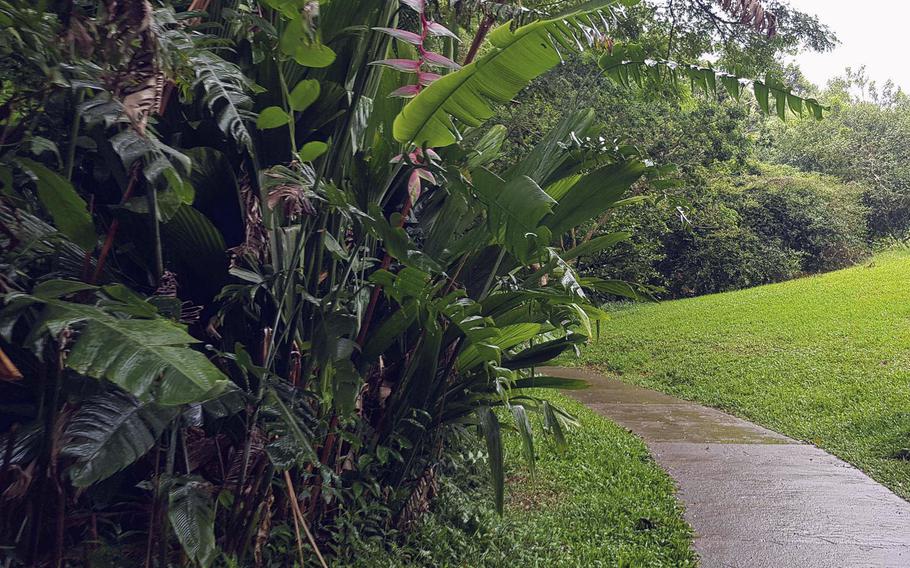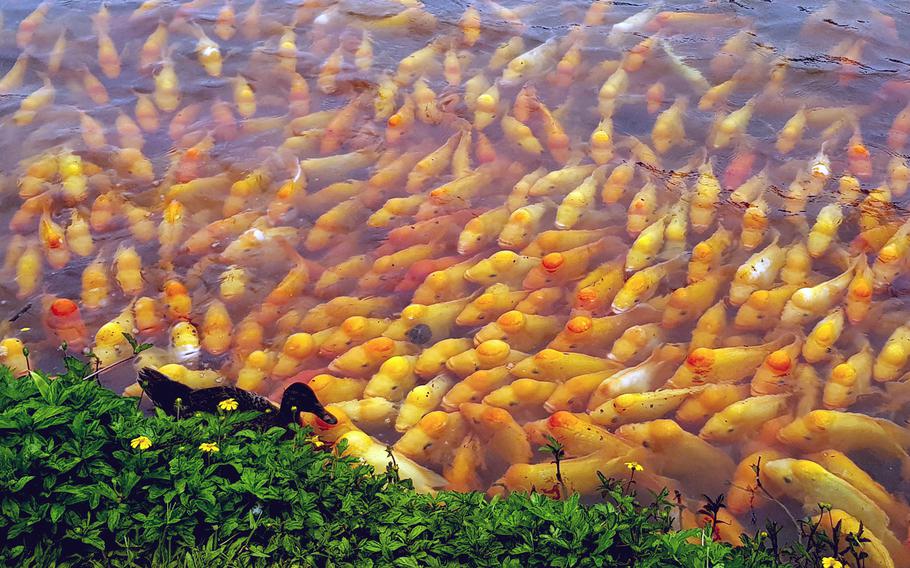
A nearby mountain range looms over Hoʻomaluhia, a city botanical garden in Kaneohe, Oahu, Hawaii. (Juan King/Stars and Stripes)
Four hundred acres of flora from all over the world await you at a botanical garden surrounded by the misty covered Koolau Mountains of Hawaii.
Hoʻomaluhia — “a peaceful refuge” — is a city botanical garden in Kaneohe, Oahu, Hawaii.
It was built more than 40 years ago by the Army Corps of Engineers as part of a flood-control project in the city and has been a relaxing place to enjoy ever since.
My family and I traveled out with friends to see the lush selections of plants from places like India, Sri Lanka, the Philippines, Malaysia, Polynesia, tropical America, Africa and the local area.
Driving down the tree-lined, mile-long roadway from the entrance gate, we took in the striking view toward the mountain ridge. So many visitors have tried for a photo of that view that stopping on that road is prohibited to forestall congestion.
Parking was free and plentiful near the visitors center, and from there we began our walk through the jungle of plants and flowers.

A pathway wends through Hoʻomaluhia, a city botanical garden in Kaneohe, Oahu, Hawaii. (Juan King/Stars and Stripes)
Highlighting each species was a label with its scientific name, where it is found and other information. As we passed through each section, we learned about plants like the Philippines’ pandan wangi, used in rice, sweets and other dishes.
After a 20-minute walk, we arrived at Loko Waimaluhia, a large freshwater reservoir.
There, visitors may feed several species of ducks, swans and a swarming number of koi, a brightly colored carp originally found in Central Europe and Asia, a fun activity by the lake. The koi looked like orange bubbles as they fought for pieces of bread. Other fish in the fray included tilapia and the Midas cichlid.
Make sure to bring raingear, which we quickly discovered we needed when a sudden rain shower arrived. Sporadic showers are common around the island but are a benefit during the summer heat.

Koi jockey for bread crumbs at the reservoir inside Hoʻomaluhia, a city botanical garden in Kaneohe, Oahu, Hawaii. (Juan King/Stars and Stripes)
For a bonus you may also see an occasional non-native mongoose scurrying in and out of the tall grass. I caught a glimpse of the small, elusive mammal as it crept out of the nearby trees just a short distance away from me.
Mongoose were introduced to the island in the 19th century to combat rats. Bringing the weasel-like creature to Oahu backfired; it also became a pest that preys on the native bird population.
Day camping is permitted on the grounds from 9 a.m. until 4 p.m., with a reservation. Camping rules are found on the website. No camping is allowed in the event of a hurricane or other severe weather.
It was hard to leave such a peaceful atmosphere with its fantastic array of flora and natural beauty. It’s worth a second visit.
On the QT
Directions: Address: 45-680 Luluku Road, Kaneohe, Hawaii 96744-1855
Times: Open daily, 9 a.m. to 4 p.m.; closed Dec. 25 and Jan. 1.
Costs: Admission is free.
Food: There are vending machines near the visitors center; bring your own food and beverages to the picnic area on the grounds.
Information: Phone: 808-233-7323; Online: honolulu.gov/parks/hbg.html